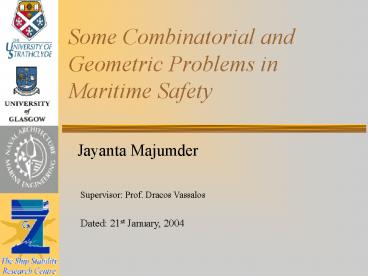Some Combinatorial and Geometric Problems in Maritime Safety PowerPoint PPT Presentation
1 / 12
Title: Some Combinatorial and Geometric Problems in Maritime Safety
1
Some Combinatorial and Geometric Problems in
Maritime Safety
- Jayanta Majumder
Supervisor Prof. Dracos Vassalos
Dated 21st January, 2004
2
Objectives
- To introduce the theme.
- To introduce the problems addressed.
- To inform about the results obtained so far.
- To outline the future directions.
- To take your valuable comments into account
3
Combinatorial Problems
- Combinatorial problems involve study of the
arrangement, grouping, ordering, or selection of
discrete objects, usually finite in number.
- The configuration space for such problems can not
be numerically parameterised.
- Challenge Combinatorial explosion.
4
Problems Addressed
- Modelling of shipboard environment for simulation
of and automated reasoning about crisis.
- Automated reasoning for crisis management.
- Mathematical problems in evacuation/crowd flow
simulation.
- Extraction of functional information from general
arrangement drawings.
5
Shipboard Environment Modelling (for Crisis
Management and Situational Awareness)
- Shipboard environment is large, whereas
individual entities of interest in a crisis
(passenger, crew, sensors, doors, hatches, fire,
fault etc.) are small and localized.
- The sum total of all localized spatial and
temporal relationships among localized entities
give rise to overall interrelationships
dependencies, but implicitly.
- An environment model is required for overall
situational awareness.
6
Automated Reasoning (for Crisis Management)
- Crisis response poses interesting combinatorial
problems.
- Constrained routing problems How to route
passengers to safety given a state of crisis,
where several pieces of localized information
about the crisis are available.
- Scheduling problems Having identified
operational tasks and their deadlines, how should
each task be scheduled with due cognizance of
available operational resources.
7
Evacuation or Crowd Flow Modelling
- Evacuation simulation involves some interesting
combinatorial and geometric problems like
geometric obstacle avoidance and planning.
- Besides its current commercial value (at S_at_S
Ltd., for example), it will serve as a predictive
tool for crisis management software.
- A new and improved formulation evacuation
simulation is being developed.
8
Syntactic Pattern Recognition
- Available general arrangement (GA) and
construction drawings are dumb, i.e. they lack
semantic information as required for reasoning
tasks.
- Current approach to creating environment model
instances is - to interpret the drawings manually
and to hand-draft the model instance.
- Automated recognition saves a lot of monotonous
work.
- Attributed-network query technology developed
here, is useful in reasoning about crisis.
9
Results So Far
- A commercialised tool for evacuation modelling.
- A graphics recognition system that recognizes
features from general arrangement drawings (Think
of a graphic find/replace system for AutoCAD).
- A software toolkit (a pipeline) to convert
scanned/CAD system prepared GAs into an shipboard
environment model with adjacency topology encoded.
10
Results So Far
- A proof-of-concept crowd flow simulation program
based on the new formulation.
- A tiny but generic input instance generator for
Monte-Carlo simulation, currently applied in fire
simulation.
- A STREP proposal for an IST project under EU-FP6
(result awaited).
11
Future Directions
- Develop a full prototype crowd flow simulator
based on the automatically inferred environment
model, and transfer the technology for
commercialisation.
- Develop automated reasoning modules that fuse
sensor data and plan about prevention and
mitigation of crisis.
- Develop onboard crisis management system
(hardware- software integration).
12
Your Comments and Questions
- My Profuse Thanks for Your Interest and Patience.

